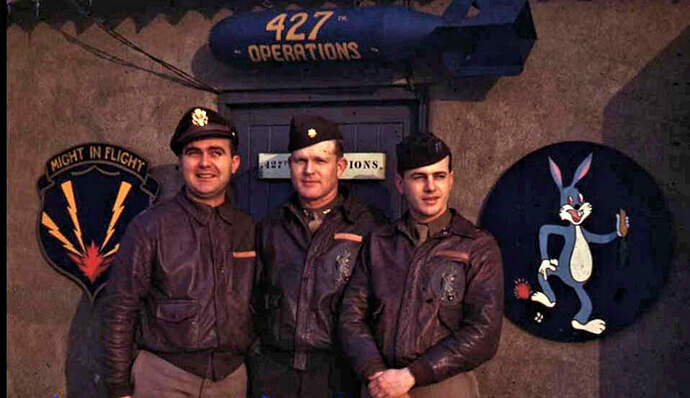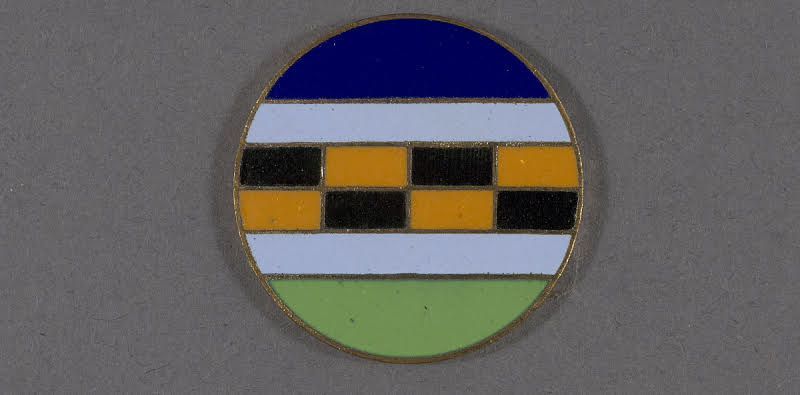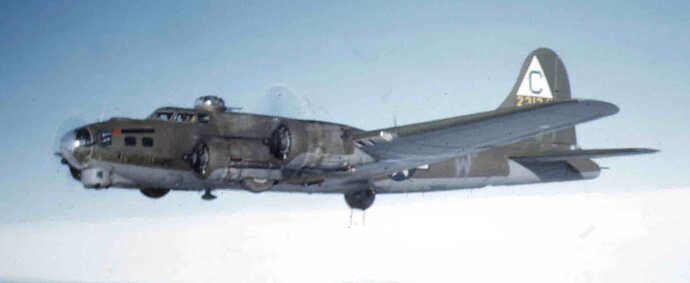Thanks for sharing this 18bravo . I remember building the White “ Turtle nose “ tank truck as a boy - back then it was molded in red IIRC .
I believe the truck tractor in the Airfix 1/72 set is an Autocar .
Too bad Airfix hasn’t bumped this up to 1/48 - perhaps they will one day . I built their Albion airfield fuel truck and it is very nice .
I believe the vehicle in front of the Crossley and shown only partially is a Fordson WOT 1 fire crash truck.
Makes sense. I looked into it and see there’s no model of it in 1/48. Even so, I am surprised how many of these (to me) obscure vehicles are model subjects. The Atlantis trailer/Gaso.line tractor combo is remarkable, as is the Crossley FWD 4x4 Foam/C02 Fire Crash Tender (RAF).
Thanks for all the “something to think about” info!
Hum. If you’re going to do this as a build, I’ll definitely follow it!
I did a double-take to see why you cut that “perfectly good” trailer! I swear I would have missed the extra curve and length up front. What was, in fact, the length of the AAF fuel trailers? Are there line drawings out there of it?
While I do plan on doing a USAAF trailer the above photo is actually for a different project.
This is the only thing I can find even remotely like plans. It’s frustratingly blurry. I’ll just to resort to some very close measuring of photos based on the diameter of the tires.
It would have to be shortened for this version, and would have the curved front cemented back on.
There’s also the trailer in the Airfix kit - the tank on this is perfect minus the skirts. I’ve thought about doing that one as well.
At any rate, here’s the blurry plans:
The drawing seems a bit foreshortened.
Wheel Hub Covers (and a History Lesson).
We are finally at the point where it is time to apply those strange main landing gear decorations to the wheel hubs from the Kits-World decal sheet
and to explain their significance. Nothing says “This is an early 427th Bomb Squadron” B-17 like they do.

Here’s the prep work done by H.G. on the covers:


and on the decals themselves:
And, to quote H.G.:
Yes I painted the edges yellow.
And here they are, on the wheels.
But why are they there, and why do they signify the 427th Squadron, whose emblem was the Bugs Bunny “What’s Up, Doc?” image?
To the right, BTW, is Robert J. Hullar as Squadron Operations Officer after his crew finished their tour and (most) dispersed back to the States. He flew Luscious Lady on both the 1943 Schweinfurt missions, Aug. 17 and Oct. 14.
Heart mysteries there, and yet when all is said
It was the dream itself enchanted me:
Extra credit if you know where these lines come from, but I digress.
Where does the design come from? It’s the squadron symbol of the 38th Reconnaissance Sqdn., the predecessor to the 427th Bomb Squadron. Read on:
The 427th Bombardment Squadron was originally the 38th Reconnaissance Squadron. They were sailing to Hawaii to join its parent, the 19th Bomb Group, when the Japanese attacked Pearl Harbor on the 7th of December 1941. The ship carrying the 38th Reconnaissance Squadron returned to the mainland and the personnel were assigned to the 427th Bomb Squadron. The 427th BS became famous with its parent, the 303rd Bombardment Group (H). Because of its initial move in the Pacific, 427th Squadron members are entitled to wear the Asia-Pacific Campaign ribbon.
http://www.303rdbg.com/missionreports/sp-427bs.pdf
That last sentence is quite something, no? An Eighth Air Force 427th Squadron member was “entitled to wear the Asia-Pacific Campaign ribbon.”
The 427th ground echelon was very proud of their predecessor unit, and that’s why the wheel hubs of (at least early) 427th A/C were decorated with the 38th Sqdn. symbol. It’s a cool historical tidbit. I’m proud I first heard this straight from some Group vets and not just in a book. (Living fossil that I am.) And enjoy a bit of my oral history, please.
And now to the actual insignia:
.
United States Army Air Forces 38th Reconnaissance Squadron distinctive insignia; orange and black checky across center of insignia; light blue stripes above and below checky; top blue and bottom green field.
We can infer that blue at the top referred to the sky and green below the land.
Meanwhile, H.G. is moving on to the props:
As an after thought… You could have a truck dropping the crew off for the start of a mission and a couple of ground crew finishing up. “Dawn of a New Day”



Regarding the F-2A trailer.
Why not?
Ouch! So the hub decals need some horribly delicate amendments – top blue, bottom green & ochre-ish yellow checks? And what are the borders - surely not gold, maybe the yellow’s OK or a darker ochre? ![]()
This is one area where “close enough, I guess,” necessarily works for me. I do have one color shot somewhere - a double exposure of David Shelhamer’s - that I will post. More discussion to follow.
Here’s the double exposure that shows the wheel hub in “color.”
As you can see, there’s not much to see in terms of color definition, other than if I had to guess, I’d say that the light rectangles in the middle are most likely painted in insignia yellow rather than orange. I say this because I know that ground crews used whatever colors they had available, and those were often limited.
In any event, I can live with the red in the decal being an approximation of the orange. Who’s to say that LL’s ground crew didn’t opt for insignia red vs. yellow to get “close enough” to orange?
It’s funny. When I spoke with David about this photo, he said it wasn’t much use because it is a double exposure, but I found it to be a goldmine once cropped. It even features on the back cover of the 303rd Osprey Elite book I wrote, what, why over 20 “yars” ago.

Also, the photo is useful because it shows 303rd crews used trucks to get the A/C. I’m ignorant about these vehicles, but I guess this is a Dodge. Suggestions, please.
I guess nobody would argue there couldn’t have been some individual variations on the hubs. Heh-heh but on the other hand…VV’s ground crew did have red paint, as seen below the cockpit window, but its hub-yellow looks like it was from the same tin as other yellow elements on the plane. Yet oddly there don’t seem to be any white bands either side of the checks, as in your earlier post of the original insignia…which I guess only strengthens your argument there were likely local variations & approximations…how’s that for a circular argument about hubs?
(If you both did decide to go with the mid-yellow check, slicing a block of that colour decal into small rectangles wouldn’t be impossible…just a major pain in the axle) ![]()
This is an uninformed comment on my part but I think with a bunch of crews heading out after a briefing that they would use any vehicle available at the time to get them to the aircraft.
If I had to hazard a guess, I’d say most crews got into trucks assigned to each squadron for transportation to their aircraft,
with some riding by jeep (but mostly for publicity shots, since crewmen had quite a bit of specialized flight clothing to return to the locker areas where this gear was stored between missions).
Tweaks to Wings and Tail Surfaces
H.G. and I have discussed the wing leading edges and tail surfaces this week.
303rd B-17s at this time had the deicer boots removed from all leading edges of the wings and tails, and the exposed aluminum painted over in the field with O.D.
You can see this in a photo of a 1943 period shot of a B-17 from the 384th BG, which always flew with the 303rd as part of the 41st CBW – Combat Bombardment Wing.
Note the red borders on the national insignia and the exposed aluminum areas on the wing leading edge in places where the field paint job was deficient.
You can see the OD leading edge even better in the below photos of the 427th Squadron’s early B-17G “Spirit of Wanette.”
Notice, too, how it wraps around the wing leading edge outboard of the landing light on the port wing.
You can also see it in this photo of the underside of “Spirit of Wanette’s” stbd. wing following the 12/20/1943 mission to Bremen.

To me, the tell is the rough demarcation line between the OD and neutral grey. You wouldn’t see that with the deicer boots.
A quick eye will also show that the leading edge of the horizontal stab still has exposed aluminum, because it hadn’t been painted yet. Compare with the preceding photo. And check out the patched battle damage all around the “W” on the fuselage. (This publicity photo was actually taken a day or two after the mission.)
On a personal note, I can’t look at this photo without experiencing some sadness. This mission was a major chapter in Half A Wing, and a principal inspiration for my writing it. The man fourth from the left is Elmer Brown, the Hullar crew’s regular navigator. I still remember meeting him in 1981 or 82 for the first time, the day after Elmer’s son Larry gave me Elmer’s diary and said his dad wanted me to “do something” with it. And the man on the extreme left is Grover C. Henderson, Jr., the co-pilot of Woody Woddrop’s (third from left) crew pictured here. Grover became a very good friend of mine and a major contributor to the book.
Both Elmer and Grover are long dead, the former of Parkinson’s Disease and the latter of a massive heart attack. Hell, even Larry died of Parkinson’s a year or so ago. Time moves on, and none of us live forever. It all just reminds me that that part of my own life is irretrievably gone, too, as will I one day.
So yeah, the Luscious Lady model is a big effing deal to me. Let’s just call it a tangible reminder of an important period in my own life, a small way for me to recall and reach back to a part of the history I had the privilege of recording for these men.
Sooooooooooooo, let’s get back to the executor of these memories and see how H.G. is doing.
Here’s a topside shot with the OD applied.

And here you can see the masking as the OD is “wrapped around” the port wing leading edge.

And here you can see the OD applied to the leading edge of the stbd. horiz. stabilizer, as well as the color contrast with the fabric flight surfaces.

You might notice the faded OD on the rudder is just the tiniest bit darker than on the elevator.

That’s H.G.'s choice on the theory that the elevators would catch more direct sunlight and fade somewhat faster. Of course, all of this will be weathered before it’s done.
Stay tuned. Things are getting more and more interesting as we near the finish line.
The End Is Near

I have long hesitated to predict when this build would be finished, and I will never hold HG to a specific deadline, but we spoke the other day, and I’m pretty sure Luscious Lady will be done by the end of this year. As I write this, he is working on the nose compartment,
has the bomb bay doors to attach, the ball turret to install, the roof of the cockpit area to complete, and all the other many details that go into “final construction.” But, no doubt, he is getting close to the finish.
Here is a “fixture” he has made for final construction.

and below are photos showing his work straightening warped Resin2Detail supercharger piping
that goes along the sides of the two inner nacelles

with hot water to soften

and press them back into shape

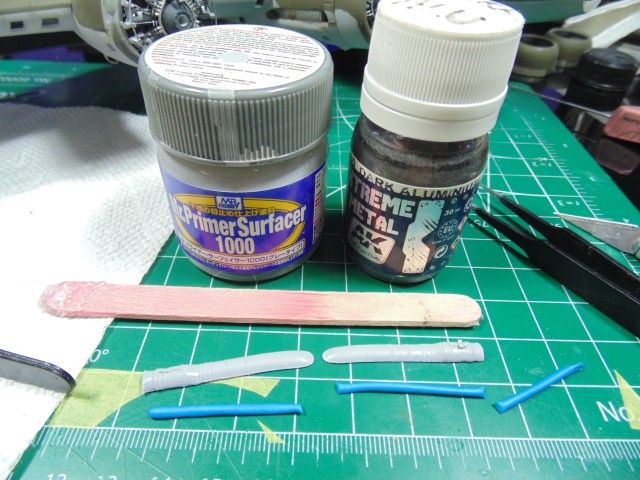
I am assuming that the blue styrene rods are mating parts to help locate and hold them into the apertures in the nacelles. But not before they are weathered.
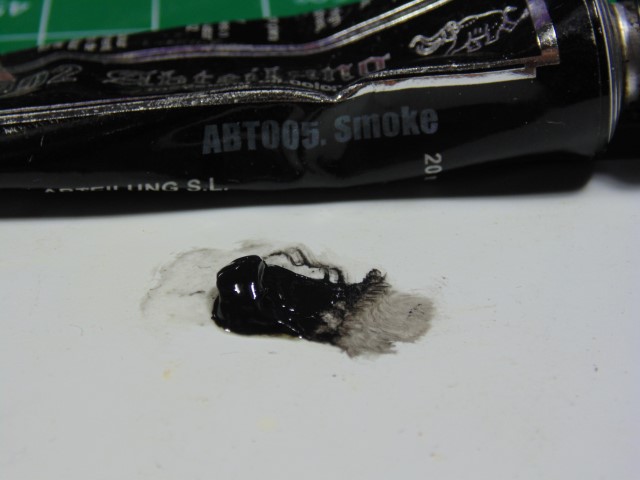
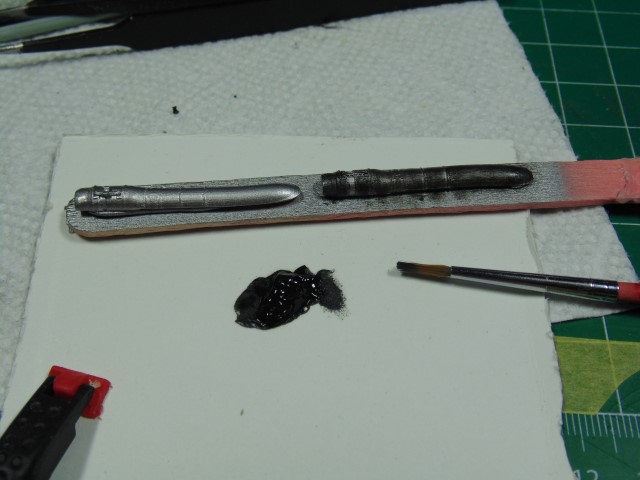
.We shall see. Give it some time.
Sir your work is incredible. The dedication to detail and accuracy is simply outstanding.
Oh bye bye, 12 o’clock high is the greatest movie








